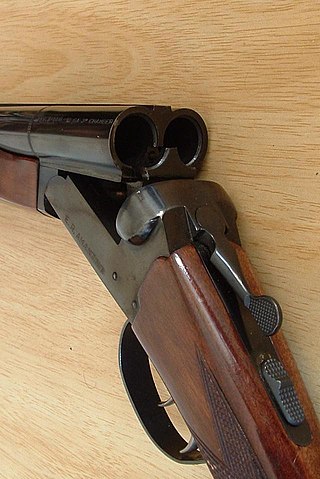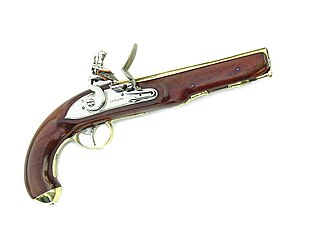
Flint, occasionally flintstone, is a sedimentary cryptocrystalline form of the mineral quartz, categorized as the variety of chert that occurs in chalk or marly limestone. Historically, flint was widely used to make stone tools and start fires.

The percussion cap or percussion primer, introduced in the early 1820s, is a type of single-use percussion ignition device for muzzle loader firearm locks enabling them to fire reliably in any weather condition. Its invention gave rise to the cap lock mechanism or percussion lock system which used percussion caps struck by the hammer to set off the gunpowder charge in rifles and cap and ball firearms. Any firearm using a caplock mechanism is a percussion gun. Any long gun with a cap-lock mechanism and rifled barrel is a percussion rifle. Cap and ball describes cap-lock firearms discharging a single bore-diameter spherical bullet with each shot.

A cartridge, also known as a round, is a type of pre-assembled firearm ammunition packaging a projectile, a propellant substance and an ignition device (primer) within a metallic, paper, or plastic case that is precisely made to fit within the barrel chamber of a breechloading gun, for convenient transportation and handling during shooting. Although in popular usage the term "bullet" is often used to refer to a complete cartridge, the correct usage only refers to the projectile.
A muzzleloader is any firearm in which the user loads the projectile and the propellant charge into the muzzle end of the gun. This is distinct from the modern designs of breech-loading firearms, in which user loads the ammunition into the breech end of the barrel. The term "muzzleloader" applies to both rifled and smoothbore type muzzleloaders, and may also refer to the marksman who specializes in the shooting of such firearms. The firing methods, paraphernalia and mechanism further divide both categories as do caliber.

In firearms terminology, an action is the functional mechanism of a breech-loading firearm that handles the ammunition cartridges, or the method by which that mechanism works. Actions are technically not present on muzzleloaders, as all those are single-shot firearms with a closed off breech with the powder and projectile manually loaded from the muzzle. Instead, the muzzleloader ignition mechanism is referred to as the lock.

Flintlock is a general term for any firearm that uses a flint-striking ignition mechanism, the first of which appeared in Western Europe in the early 16th century. The term may also apply to a particular form of the mechanism itself, also known as the true flintlock, that was introduced in the early 17th century, and gradually replaced earlier firearm-ignition technologies, such as the matchlock, the wheellock, and the earlier flintlock mechanisms such as the snaplock and snaphaunce.

A wheellock, wheel-lock, or wheel lock is a friction-wheel mechanism which creates a spark that causes a firearm to fire. It was the next major development in firearms technology after the matchlock and the first self-igniting firearm. Its name is from its rotating steel wheel to provide ignition. Developed in Europe around 1500, it was used alongside the matchlock and later the snaplock (1540s), the snaphance (1560s), and the flintlock.

A matchlock or firelock is a historical type of firearm wherein the gunpowder is ignited by a burning piece of flammable cord or twine that is touched to the gunpowder by a mechanism that the musketeer activates by pulling a lever or trigger with their finger. This firing mechanism was an improvement over the hand cannon, which lacked a trigger and required the musketeer or an assistant to apply a match directly to the gunpowder by hand. The matchlock mechanism allowed the musketeer to apply the match himself without losing his concentration.

A snaphance or snaphaunce is a type of firearm lock in which a flint struck against a striker plate above a steel pan ignites the priming powder which fires the gun. It is the mechanical progression of the wheellock firing mechanism, and along with the miquelet lock and doglock are predecessors of the flintlock mechanism.

The flintlock mechanism is a type of lock used on muskets, rifles, and pistols from the early 17th to the mid-19th century. It is commonly referred to as a "flintlock". The term is also used for the weapons themselves as a whole, and not just the lock mechanism.

Miquelet lock is a modern term used by collectors and curators for a type of firing mechanism used in muskets and pistols. It is a distinctive form of snaplock, originally as a flint-against-steel ignition form, once prevalent in the Spanish, Portuguese, and Ottoman empires, Italy, North Africa, and the Balkans from the late 16th to the mid-19th century.

The lock of a firearm is the mechanism used to initiate firing. It is a historical term, in that it generally refers to such mechanisms used in muzzle-loading and early breech-loading firearms. Side-lock refers to the type of construction, in which the individual components of the mechanism are mounted either side of a single plate. The assembly is then mounted to the stock on the side of the firearm. In modern firearm designs, the mechanism to initiate firing is generally constructed within the frame or receiver of the firearm and is referred to as the firing or trigger mechanism.

A snaplock is a type of lock for firing a gun or is a gun fired by such a lock.

A touch hole, also known as a cannon vent, is a small hole at the rear (breech) portion of the barrel of a muzzleloading gun or cannon. The hole provides external access of an ignition spark into the breech chamber of the barrel, either with a slow match (matchlock), a linstock or a flash pan ignited by some type of pyrite- (wheellock) or flint-based gunlock, which will initiate the combustion of the main gunpowder charge. Without touch hole, it would be nearly impossible to ignite the powder because the only otherwise access into the barrel is from the front via the muzzle, which is obturated by the projectile.
The flash pan or priming pan is a small receptacle for priming powder, found next to the touch hole on muzzle-loading guns. Flash pans are found on gonnes, matchlocks, wheellocks, snaplocks, snaphances, and flintlocks.

The Colt Army Model 1860 is a cap & ball .44-caliber single-action revolver used during the American Civil War made by Colt's Manufacturing Company. It was used as a side arm by cavalry, infantry, artillery troops, and naval forces.

The hammer is a part of a firearm that is used to strike the percussion cap/primer, or a separate firing pin, to ignite the propellant and fire the projectile. It is so called due to the fact that it resembles a hammer in both form and function. The hammer itself is a metal piece that forcefully rotates about a pivot point.

A handgun is a firearm designed to be usable with only one hand. It is distinguished from a long gun which needs to be held by both hands and braced against the shoulder. Handguns have shorter effective ranges compared to long guns, and are much harder to shoot accurately. While most early handguns are single-shot pistols, the two most common types of handguns used in modern times are revolvers and semi-automatic pistols, although other handguns such as derringers and machine pistols also see infrequent usage.
The following are terms related to firearms and ammunition topics.
In firearms and artillery, the primer is the chemical and/or device responsible for initiating the propellant combustion that will propel the projectiles out of the gun barrel.















